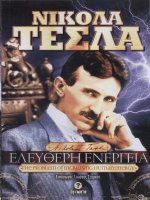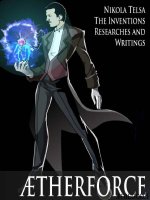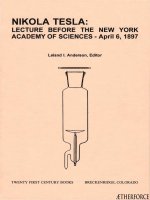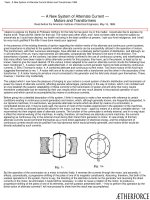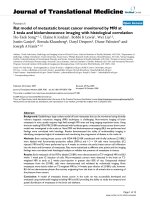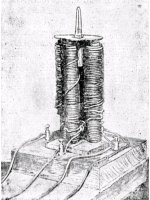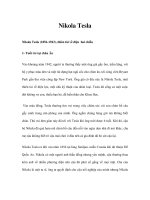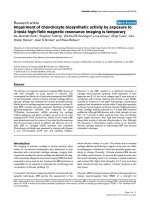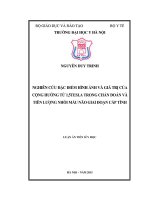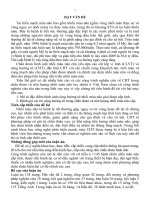nikola tesla - lecture-before-the-new-york-academy-of-sciences-apri-6-1897
Bạn đang xem bản rút gọn của tài liệu. Xem và tải ngay bản đầy đủ của tài liệu tại đây (11.32 MB, 139 trang )
NIKOLA TESLA:
LECTURE BEFORE THE NEW YORK
ACADEMY
OF
SCIENCES -
April
6,
1897
Leland
I.
Anderson,
Editor
TWENTY FIRST CENTURY BOOKS BRECKENRIDGE, COLORADO
ÆTHERFORCE
NIKOLA TESLA:
THE
NEW
YORK ACADEMY
OF
SCIENCES
6, 1897
ÆTHERFORCE
Nikola
Tesla
International TelecommWlications Union
ÆTHERFORCE
NIKOLA'TESLA: BEFORE
THE NEW YORK ACAD8v1Y OF
The
Streams
oHenard
and
Roentgen
and
l\!ovel
Apparatus
lOr
Their
Prcxiuction
April 1897
Reconstructed
Leland
1.
Anderson, Editor
1994
TWENTY
ARST
CENTURY
BOOKS
BRECKEI\lRJOOE.
COLORAOO
ÆTHERFORCE
Copyright
©
Leland
Anderson
All
rights
reserved.
No
p'dlt
of
this
book
may
be
reproduced
in
any
fonn
or
by
any
means,
electronic
or
mechanical,
including
photOCOpying,
recording,
or
by
any
mfOrmatIon
storage
and
retrieval
system,
without
permission
in
writing
from
the
publisher,
of
,, ,ll.;UV:':
Card Number: 94-61004
ISBN 0-9636012-1-0(hardcover)
0-9636012-7-X
(soft cover)
First Century Books
P.O. Box 2001
Breckenridge, Colorado 80424
ÆTHERFORCE
Contents
Figures
Editorial
Introduction
Setting
on non-publication
of
Lecture Commentary
High frequency apparatus
Lenard
Roentgen
actions from Lenard and Roentgen
The
vii
viii
ix
xiii
1
3
7
7
18
26
I -
29
Improved Apparatus for the Production
of
Powerful
Electrical Vibrations; Novel Frequency Measurement
Methods.
Section I Addendum
71
Wireless Telegraphy Receiving Methods.
Section
II
83
The Hurtful
"\ ClIVlli>
of
Roentgen
""'''''''''Vll
III
-
95
The Source
of
"-'V''''''L)::;''H
Con-
and
Appendix
109
Contemporary reviews
of
lecture
III
Acknowledgments
117
ÆTHERFORCE
VI
Sponsorship
Index
CONTENTS
118
121
ÆTHERFORCE
LC
I
-I
1-2
1-3
1-4
1-5
1-6
1-7
1-8
1-9
Figures
Form
of
listing: Sec. !f Fig.
If
node
in
circuit)
Method
of
transformation
of
electrical energy by oscil-
latory condenser discharges
Mechanical
of
electrical oscillator
illustrated
in
Coil wound
to
secure
I with self-induction coil
increased
r.,,,,,,r:lfv
a secondary coil with a primary circuit coil
System
for existing
circuits
Circuit controller allowing condensers connected
to
dis-
charge circuit and
~ll<~~~~~.v~1
H"'5"""v""
of
parts and circuits
of
a small oscillator
of
small oscillator diagrammatically shown
8
Apparatus for the manufacture
of
condensers and coils
High potential coil system having terminals at centers
Photograph of coil system illustrated in
II
in action
vii
14
34
35
37
37
38
38
39
39
41
46
48
52
1-10
! - I I
1-12
1-13
instrument
to
determine
1-14 Method
of
impulse illumination
of
instrument disk
and phase
62
67
IA-I5
Devices for
IA-16 Other ways
of
IA-17 interrupter)
IA-18
IA-
111-
1lJ-2
111-3
111-4
(A
series
of
six photographs
of
drawings
of
120 bulbs
exhibited
on
walls
of
New York Academy of
Illustrating an experiment the real source
of
the rays
Improved Lenard tube
arrangement with improved double-focus
tube for reducing actions
Illustrating arrangement with a Lenard lube for safe
working at close range
'72
73
74
74
76-81
97
102
103
106
ÆTHERFORCE
viii
Editorial Remarks
Section I
of
this lecture is presented with few changes from
the original text by Tesla, an illustration
of
which
is reproduced on page
30. The text would have benefited
an editor's hand if presented to a publisher at that
but
no
such editorial "smoothing" has been attempted in
presentation now.
Only minor changes have been intro-
duced, such as in words that were separated before the turn
of
the
century but now appear solid. They
are:
electro-
magnetic, electro-motive, in as much, foil, wave
length. few articles and prepositions were missing, and
their have set in brackets
[].
As
an additional to the reader, certain items have been
marked brackets with an explanation provided in a note.
figures
13
ab,
14,
and
16,
together with the
photographs
of
drawings
of
120 bulbs
76-81, have
Section
I appeared among a group
of
papers passed on to
children by George Scherff, who was Tesla's personal
secretary, business manager, and confidant from 1895
through A also in the archives
of
Tesla
Museum copies, were
mISSIng
some illustration drawings and photographs. These were
drawn from the archives
of
Knight Brothers and Boyle
Anderson.
ÆTHERFORCE
Preface
Nikola T esla was born
of
parents at Smiljan, the
Austro-Hungarian border province
of
Lika, now part
of
Croatia, at midnight July 9-10, 1856. His father, Milutin,
was a Serbian Orthodox priest, and mother,
nee Djouka
Mandie, was a family line whose sons were the clergy
and whose daughters were wives
of
the clergy. Serbian
Orthodox church then used the Julian calendar, and it con-
tinues to use this today for days observance. The
American colonies converted to the Gregorian calendar
years before arrived at
York in 1884. When
crossed 'date '
11
days dropped his per-
sonal calendar. Most institutions observe Tesla's birth date
as 10, which date held for himself, but if the
tolling church Lika could have heard in Ameri-
ca when Tesla was born, the calendar date would have been
July 21,
Establishing himself in
United States, became a
in 1891. brought to the world
great'
gifts
for which he induction motor and the
multi-phase alternating current power distribution system
driving it (1888); the fundamental system wireless
raphy embodying
"Tesla coil" (
(1898); the Tesla turbine (1913-20), which attracting great
interest; and, among many leading inventive achieve-
VTOL (1928).
* The Tesla family moved to nearby when Nikola reached the
age
of
six
to enter school. Adding to the uncertainty
of
the date accord-
ed Tesla' s birth
is
an official certificate
of
birth entered for him
by
the
city Gospic his birth date as June 1856. certificate
is
reproduced in Nikola Tesla: with Relatives (Bel-
grade: Nikola Tesla Museum, 1993;
in
Serbian and English), illus.
sec. I thank Milan Radovic,
of
Wisconsin-Madison Li-
braries. for translating this
~'61HH',all'
ÆTHERFORCE
x
PREFACE
50 following the presentation
of
the principles
wireless telegraphy now called at his in
Teslaasserted inventive claim. It
wasn't
until five
months following death in 1943 that the
United
Supreme court declared the basic radio patent Marconi in-
valid, the prior art
of
Tesia for system con-
cept and apparatus, Stone the method
of
selectivity, and
Lodge variable tuning.
In his lifetime, Tesla was granted over
30
honorary degrees
and foundation medals from the
world over.
The
unit
magnetic flux density in the MKS system was named "tesla"
on
the occasion
of
the centennial year
of
his birth. The only
other
to share such recognition is Joseph
The
1897 lecture before the New York Academy
of
Sciences
was the sixth historic lectures delivered in rapid succes-
sion in America and in
The
previous five lectures
were:
of
Alternate-Current Motors,"
May
16,
of the American Institute Elec-
in
New
York followed
by
the
trio series
of
demonstration lectures on high frequency and
high potential alternating currents,
the
first,"Experiments
with Alternate Current
of
Very
High Frequency and Their
Application to Methods
of
Illumination," May
20, 1891, before a meeting of the
New
York City;
the second,
"Experiments with Alternate Currents of High
Potential
and High Frequency," February 3, 1892, before
the Institution
of
Electrical Engineers, London, followed a
day (with some condensation)
by
special request
at
the Royal Institution, and
by
invitation, February
19,
be-
fore
the Societe Internationale des Electriciens and the So-
ciete
Francaise Physique; and the third,
"On
and
Other Phenomena," February 24, 1
before Institute Philadelphia
and
(with
some variation) March
1,
before a meeting
of
the Nation-
al
Electric Light Association in
St.
Louis (it
was
in the
latter that the principles of radio commUnI-
cation were first presented); and
and
cal
Oscillators," August 25, 1893, a meeting of the
ÆTHERFORCE
PREFACE
xi
International Congress at the Columbian Exposi-
tion in Chicago, and (with some variation) November
before a meeting the New York Electrical
"""'1-""
delivered four additional ''''''''.'Ull,,"' lectures
or
absentia, the last
in
1911.
e
in
ÆTHERFORCE
Introduction
There are more things
in
heaven
and
earth, Horatio,
than are dreamt
of
in
your
philosophy.
Hamlet, Act I, Scene 5
In 1895, the fluorescent coating
of
a cardboard screen of-
fered
just
enough illumination for Professor Wilhelm Con-
rad Roentgen to find his way to the discovery
of
the X ray.
The implications
of
his discovery for the medical profession
were,
of
course, no less than staggering. Yet history has
shown that its implications for the world
of
physics were
more far-reaching than anyone could have imagined.
At the time
of
Roentgen's discovery, many scientists were
quite comfortable with the Newtonian explanation
of
the
way the universe worked and even discouraged students
from pursuing careers in physics because, as they thought,
physics offered little career potential: almost everything al-
ready had been explained! A few notable exceptions, among
them black-body radiation and the Michelson-Morley experi-
ment, challenged the neat and simple explanations
of
New-
tonian physics, but the world
of
science was confident that
these phenomena soon would be understood.
The
nature
of
light and electricity (ether waves vs. radiant matter) and the
structure
of
the atom were still in the question-forming
stage. Roentgen's discovery
of
the X ray signaled the end
of
two centuries' confidence in Newtonian physics. With little
reservation, the discovery
of
the X ray can
be
considered the
birth
of
modern physics.
Where, boundless nature, can I hold you fast?
Faust, 455
The trail leading to the discovery
of
Roentgen's invisible
light began in the seventeenth century with two chance
observations
of
visible light: Von Guericke noting that a
ÆTHERFORCE
xiv
INfRODUCl'ION
faint glow occurred between his hand a spinning sulfur
ball
Piccard finding that light is from mercury
sloshing around the top a barometer. By the early
eigh-
teenth Hawksbee, knowing that a vacuum had been
present in upper part
of
Piccard's barometer, constructed
glass vessels removing some the air. He excited them
with frictional electricity and observed beautiful glowing
streams
of
colored light. Almost a century and a half passed
before the real significance
of
this accelerated
would begin to be
The
1790 introduction
of
Volta's electric battery allowed
Oersted, Ampere, Faraday, and Henry to deduce the
rela-
tionship between electricity and magnetism. Page
Rhumkorff induction the high voltage
transformers, which could increase the few volts from a
bat-
tery
to
many thousands volts. In the Geissler
veloped an efficient vacuum pump, similar to
Piccard's
which employed the weight
of
to pull
the air out
of
a glass a glass blower, fabri-
cated many types
of
tubes, evacuated them using his
own
new pump, and watched them glow with beautiful col-
ors when high voltage from induction coils was applied.
Variations in the composition, the kind
of
gas, and the
level
of
vacuum were used
to
expand the multicolor effects
of
Geissler tubes.
equipment improved, higher vacuums were attained;
PlUcker, Hittorff, and Crookes observed streams
of
light
emanating from the negative electrode
of
some
of
their dis-
charge tubes. Furthermore, a magnet was seen to bend and
deflect this stream, called the cathode ray. Crookes,
Gold-
stein, and Perrin designed many variations
of
vacuum
charge most
of
which demonstrated new
of
cathode ray. Magnetic-effect, paddle-wheel, and canal-ray
tubes were only a few
of
such types.
In
the nineteenth century, true nature of cathode
was a subject
of
much controversy. In 1803, Thomas
Young showed that
light had a wave nature and many scien-
tists assumed that cathodic light (one name given to cathode
rays) was just another light wave traveling in the ether.
However, Crookes, among others, saw cathode ray as a
ÆTHERFORCE
INfRODUCTION
xv
stream
of
matter particles which
In 1890, constructed an
were found to exit a
aluminum
In
left his student,
their experiments. Lenard
the experiments that Hertz
sen ted Roentgen
wi
th some
plish them.
termed
"radiant matter."
in which cathode
through a thin
His untimely death
with task
of
continuing
Roentgen to repeat some
of
he had conducted and pre-
with which to accom-
many scientists
of
his day, Roentgen focused
on
the cathode ray. On the evening
of
November 1895,
he
carefully covered a discharge tube with a black cardboard to
prevent the light in tube from with his
gation. Immediately upon energizing the Roentgen no-
ticed a greenish glow emanating from a nearby cardboard
screen that been with a chemical compound
known to in the
of
cathode rays. Cathode
rays had never been known to journey more than a cen-
rnA',,,,,,",," from tube, and the cardboard
screen was more than a distance from tube,
Roentgen concluded that the glow he was the
feet
of
a new kind
of
During the course
of
further
"-""'V", Roentgen to his to
as he held sman lead fishing in front the dis-
tube: shadow the bones in his were
cast on the fluorescent cardboard.
The
discovery was made. Given certainty that
rays were being produced in quantities by
the discharge tubes in use at the time, X rays might have
discovered by any number
of
scientists during the pre-
vious several decades. Rather than diminishing
Roentgen's
achievement, however, this it considerably,
demonstrating not
only
genius in
what was happening but his in stopping to
On December 28, 1895, Roentgen published about
copies
of
preliminary paper and distributed them to
local colleagues in Bavaria. Early in he made an-
nouncement to rest
of
the world.
The
of
living bones tissues their
bodies was disconcerting to most people, to say the
ÆTHERFORCE
xvi
INTRODUCTION
A New Jersey proposed a bill to outlaw the mak-
ing
of
opera glasses, while a manufacturer
offered X-ray-proof undergarments. In Roentgen's
own
culture, the sight
of
bones presaged imminent death, and
Roentgen's wife was horrified by the in hand.
Obviously, the most immediate application
of
the new
covery was in medical world, and medical practitioners,
scientists, and instrument companies any information
they could get. Crookes-type vacuum discharge tubes and
induction coils were not easy to find outside
of
university
physics laboratories. A Boston dentist, William
1.
Morton,
actually made use
of
a simple light bulb connected to a bor-
rowed induction coil to produce
some
the first X-ray
ages in the
United On 11, 1896, the New
York
Electrical
Review
answered the for information
about X rays by launching a
of
eight by Niko-
la in which he presented many new ideas, inventions,
and dealing with the ray, its production, use, and
explanation.
The
What
is the craze,
The town's ablaze
With the
new
phase
of
ways.
Wilhelmina
Electrical Review (London)
17, 1896
Anderson's
reconstruction
of
Tesla's
lecture before the New
York
Academy
of
on
April
6,
is a most
portant contribution. In this Tesla went beyond his
titled
"The Streams
of
and
Roentgen
Novel for Their
Production,"
and
expanded
on
his X-ray articles published in the York Electrical
Re-
view. large
of
his vacuum tubes were
displayed
on
the walls
of
the halL the tubes
re[)re~;entea
were not
only
Crookes and types but va-
of
single-electrode tubes
of
Tesla's
own
invention,
some
of
which were used for his Roentgen-ray demonstra-
tions accompanying lecture.
ÆTHERFORCE
INTRODUCTION
xvii
During lecture, discussed the uses
of
some
of
tubes in his experiments with wireless telegraphy. Among
his tubes, said, were
"a
great number
of
de-
"Compare
this statement with 1916 re-
by Anderson in first book
of
this series, Nikola
On His Work With Alternating Currents: "Well, in
some
of
these bulbs I have shown, for instance, that a heat-
conductor a stream or as I said at that
charged particles, a few
of
bulbs have been
exactly in the same manner the audion is used
today."
is
prompted to ask, "What was Tesla really
in his research and experimentation with vacuum
tubes?" His statements about using the tubes in the receiving
and detection
of
wireless offers clues. his
ture before the Academy, often referred to Lenard-
Roentgen-streams and tubes; obviously considered
Lenard and Roentgen to hold equal in the
of
X The Lenard tube,
as
well as
mentation, were
of
particular interest to Tesla that
'"""'""""'"'"
rays (streams electrons) actually emanated from the alu-
minum window opposite the cathode
of
tube and pro-
ceeded a centimeters into air. research by
Corum and Kenneth Corum indicates that Tes]a was
looking for methods
of
moving electrons with such devices
as open-air diodes
or
even relativistic electron-beam (REB)
diodes, which,
if
as they are built today, including
power supply, resemble
closely a Tesla coil and a Lenard
tube. speculation about Tesla's moving electrons is,
perhaps, only the
of
the story. Other
particularly his on particle beam weaponry, points
to interest in moving larger
Another great value Anderson's contribution in
recon-
structing this leeture is that it shows
us
historically the extent
of
Tesla's work with vacuum tubes up to 1897. Roentgen's
announcing the discovery the ray Tesla with
yet another area in which to contribute discoveries and
inventions. This lecture on the rays Lenard and Roent-
and Tesla's series articles in New
York
Review contain material far more advanced than any
other contemporary work. 1897 lecture discussion
of
"reneeted" Roentgen offered with data tables,
ÆTHERFORCE
xviii
INfRODUCTON
almost exactly to Arthur
H.
Compton's 1922
monograph on the topic
of
secondary radiation.
offered a design apparatus to generate
"reflected" rays.
lecture is a fount
of
information beyond the knowl-
edge
of
most of his
contem}X>raries,
a wide array of
tables, charts, diagrams, photographs, designs,
and suggestions
of
one process after another for the produc-
tion
of
X rays, the use
of
vacuum tubes, and special
dures for refining the operation of
all
kinds
of
apparatus.
Tesla, here and in other works, discussed scientific
princi-
ples not "discovered" until years later.
The most significant contribution
of
this text . rerhaps,
that it shows in his true light one
of
Vlslonanes
that ever man far ahead
of
his peers yet gentle and
willing to give what he had to the world. With regard to
the
relationship between Tesla's work and the world
of
",-,<,-,u","
it is curious to note that it has taken a better part
of
the last
100 years since his invention
of
the resonant for
to truly
in
duplicating the coil
sign, this in spite
of
the great pains went to in making his
recommendations clear. Let
us
hope that, as more informa-
tion on Tesla's work becomes available, much greater atten-
tion will be
to
it, to the betterment
of
our world.
Jim Hardesty
Judith Hardesty
I thaca, New York
June 1994
ÆTHERFORCE
cannot help looking at that little bulb
of
Crookes with a feeling akin to awe, when he
considers all that it has done for scientific pro-
gress-first,
the magnificent wonderful achieve-
ments
of
Roentgen. Possibly it
may
still contain
a grateful Asmodeus, who will be let out
of
his
narrow prison cell
by
a lucky student.
At
times it
has
seemed to me as though I myself heard a
whispering voice, and I have searched eagerly
among
my
dusty bulbs and I fear
my
imagination has deceived me, but there they are
still,
my
dusty bulbs, and I am still listening hope-
fully.
N,
Tesla
March
7.
1896
ÆTHERFORCE
Background
Setting
1897 the New Academy
of
u\./I'",11'-"",,:)
did not appear in entirety in Tesla's lifetime. In an extend-
ed
1916 interview he remarks,
lecture was not published I had to a lot
of
things. I had undertaken an extensive program, and I
found that my energies were not adequate to the task.
Later on, the subject was neglected; other business
vented me from doing anything It only
typewritten form, uncompleted.,,1
original as delivered, carried title,
"The Streams Lenard and Roentgen and Novel Apparatus
for
Production,"2 but actuality it went far beyond
that topic.
On the walls
of
the hall Tesla displayed
proximately
120 drawings
of
vacuum tubes that he or-
dered built in by his laboratory technicians.
Many
of
these were
of
Lenard type and also the single-
electrode type pioneered by him and used demonstrations
of
methods in lecture. Among the drawings were
tubes wireless telegraphy experiments. The hereto-
unpublished portion
of
the 1897 text cov-
ers, with
of
on X-ray
NikoJa
TesJa
On
His
Work With Alternating
Currents and Their Application
to
Wireless Telephony,
and Transmission
of
Power (Denver: Sun Publishing, 1992),
p.
158.
(Editorial)
"The New York Academy
of
Science: An
Electrical Exhibition Address Nikola Tesla announcing recent
achievements," Electrical
Review
(N.Y.), Apr. 14, 1897,
p.
175;
"Mr.
Tesla on Rays,"
p.
398, and (Review)
"Mr.
Tesla the New York
of
"EJectricalEngineer,
Apr. 14, 1897, pp. 400-401; the latter was published under the title,
"Mr.
Tesla on X Rays," in the Electrical
Review
(London) May
7,
I
p,
626. See Appendix for reproductions
of
these reviews.
3 The term
"X
ray" had not, at the time
of
this lecture, been gener-
acceptc!<l
for the rays
of
Roentgen.
ÆTHERFORCE
2
BACKGROUr TD
discovery, high frequency resonators and measurement
methods. In addition, Tesla an extension
of
the
measurement topic into wireless telegraphy receiving meth-
ods which
is
as an Addendum. These topics are
not suggested title.
I
t is concluded that subject matter the lecture specifi-
covered by its title was published over name in
communications entitled
''Tesla on the Hurtful Actions
of
Lenard and Roentgen and ''Tesla on
of
Roentgen Rays and Practical Construction Safe
Operation Lenard Tubes," Electrical Review (N.
Y.),
May 5 and
11,
1897, respectively. portions
of
the lecture immediately follow the Addendum. With ex-
ception the first five introductory sentences
of
the
communication referencing the lecture before the Academy,
the segments plus added from the 1916 inter-
view the Addendum) allow one continuous reading as
the complete lecture.
outline
of
the
lecture
is
as follows:
Improved Apparatus the
Production
of
Powerful
Electrical Vibrations; Novel Frequency Measure-
ment Methods.
Section I
- Addendum
Wireless Telegraphy Receiving Methods.
Section
II
Hurtful Actions Lenard and Roentgen
"'1"'
"'
III
The Source
of
Roentgen Rays and the Practical
struction and Operation
of
Lenard Tubes.
There are perhaps two combining reasons why the lecture
was not published entirety as delivered.
as points out
of
the
IVV'.Ulv
and in the 1916 interview, to the intense research
engineering activity he was at that time
Some
of
ÆTHERFORCE
THESEITING
3
include (a) crystallization
of
his
telegraphy, telephony, and transmission
of
of
patent coverage; (b) the
on
wireless-controlled telautomata; (c) the development high
intensity phosphor-coated vacuum-tube the
fluores-
cent lamps today; (d) time-consuming task
his patent courts.
The second reason relates to
the growing, highly competi-
tive atmosphere
in
wireless telegraphy development now
recognized as radio. at that applications for
the fundamental patents in teiegraphy,4 undoubt-
edly realized that
detailed information contained in this
of
the (presented as I) was
of
propri-
etary and it would given away without first
obtain-
ing protection through patent applications. Whereas Tesla
had giving freely to the world many technological
ideas,
In
his trio series delivered
in 1891, and
5 he now grew more cautious, and
rightfully so, in protecting his own economic interests in the
field of wireless communication.
Skirmishes
on
non-publication
of
lecture
that
In
United weekly
I'Arnm,"',.",
electrical journals were published: Electrical
Electrical
Review,
Electrical World, Electrician, Electricity,
and Western Electrician. In addition to these were week-
ly American, which reported
on
a mix
of
scientific
as well as monthly
periodicals
Electrical and Engineering
4 U.S. Patent No.
of
March 20, 1900,
of
Transmission
of
Electrical " and U.S. Patent No.
of
May 15, 1900, "Apparatus for Transmission
of
Electrical Energy,"
both applications filed 2, 1897.
5 Martin,
T.e.,
The
Inventions. Researches and Writings
of
Nikola (New York: The Electrical 1893), chs. 26-28
(pp. 145-373).
ÆTHERFORCE
4
BACKGROUND
Magazine. early publication activity was primarily a
the vast electrical industrialization and
opportunities that sprung from inventions
in the direct-current realm and, subsequently, the
inventions
of
Tesla in alternating-current realm. The mar-
was unquestionably electrical news
coverage, and commercial electrical journals fought to
alive.
Thomas Martin, serving as president
of
the American
Institute
of
Electrical for the under-
took editorship
of
Electrical
World
in December 1888 but
was discharged in March
1890 over a dispute with the
owner the publication on compensation. The feud was
aired on seven tabloid-size pages in the September
30, 1893
6 Martin subsequently found a as editor
of
Engineer.
In
the Company published the
book,
The Inventions, Researches and Writings
of
Nikola
Tesla,
compiled
by
Martin, chief editor. This
re-
mains a classic a century later having been republished sev-
eral times.
7
years before death Martin remarked in a letter to
Thomson, some money out my
book, which was promptly borrowed from me by the titular
component, so that two
of
work went for nothing."g
The Company was undoubtedly in
financial condition as the letter
offered to Martin in lieu
of
cash receipts
book.
6 I am indebted to Marc his forthcoming work,
The
TesJa
Trilogy, for this revealing insight concerning Martin's busi-
ness relationship with Tesla.
7 The firs I reprint
was
undertaken in 1952 by the Lee Engineering
Co.
of
Madison, Wise., as a contribulion to the engineering industry.
8 Jan. 16, 1917,
in
Selections from the Scientific Correspondence
of
Elihu Thomson, Abrahams, R.J., and M.B., eds.
bridge, Mass.:
MIT
1971).
ÆTHERFORCE
SKIRMISHES ON NON-PUBUCATION OF LECfURE 5
During the year prior to the 1897 Academy Sciences lec-
ture, the
Electrical
Review published a remarkable series
of
communications from Tesla in the journal on
the
sub-
ject of material stream emanations.
9
Not
to
be
outdone,
Martin presumably persuaded Tesia to have
the
Academy
lecture
published in the
Electrical
But obvi-
ously had second thoughts for reasons
Martin, perhaps not fully appreciating the role an inde-
pendent inventor depending for his upon suc-
cessful marketing
of
patented inventions, could not accept
decision to not complete the lecture for publication.
Martin had a ravenous appetite for
to
make the
Electrical
Engineer financially successfuL The following
year,
Martin allowed to published in November 17,
1898 without permission, TesIa's paper, "High
Frequency Oscillators for Electro-therapeutic Other
Purposes,"
presented the eighth annual meeting
American Electro-Therapeutic Association in Buffalo,
New
York,
September 14, 1898.
An
editorial salvo entitled
"Mr. Tesla and the also appeared in the same
issue-a
sort
of
'tit for tat' rejoinder on the non-publication the
Academy
of
Sciences lecture-together with a specific pa-
editorial, ''Tesla's Electrical Control
of
Moving
Vessels or Vehicles from a
Distance," dwelling on
the
im-
practicality of his recent invention. 10
Martin certainly went beyond professional ethics in publish-
ing
the
lecture. Undoubtedly,
the
stress
of
financial
problems of the
Electrical
Engineer
was too trying. He need-
ed 'leading-edge' and Tesia was not producing
it.
9 "Tesla's Startling Results in Radiography at Great Distances
Considerable Thickness
of
Substances," Mar.
11,
pp. 48, 49;
"Tesla's Latest Results,"
Mar.
18,
pp.
146, 147; "Tesla on Reflected
Roentgen
Rays," Apr.
1,
pp.
171-174; "Roentgen Radiations,"
Apr.
8,
pp.
183-186; "Tesla's Latest Investigations," Apr. pp.
206-211; "Tesla Describes an Feature
of
the X-Ray
Radiation," July
8,
p.
43; "Roentgen Rays or Streams," Aug. 12,
pp.
78, 79, 83; and "Roentgen Streams," Dec.
2,
pp. 277,
X.
10
U.S.
Patent No.623,809 of Nov.
8,
1898, "Method and Apparatus for
Controlling Mechanism
of
Vessel or Vehicles," application filed
July
1,
1898.
ÆTHERFORCE
6 BACKGROUND
Tesla was furious unauthorized publication
prior
to
the opportunity given the American Electro-Thera-
peutic Associatlon to publish in its
Transactions,
II
and sent
copies
of
his severe to all electrical journals in
America and Electrical Engineer also carried
the letter with accompanying defensive commentary running
four columns in the November 24 issue.
To
understand the crisis facing the Electrical
Engineer,
one must ahead another three months to March
11,
1899, when Engineer was taken over
the
Electrical merged publication becoming
apr
"',rn
World Martin was retained, but as
co-editor. temperament, he perhaps did not
perceive as did others. Years later, in
fiftieth
of
Engineering, the
fidal journal Martin's misadventure with
Electrical Engineer was not mentioned.
It
should not that Martin held a
grudge toward even though later promoting
'U~"''''''Jl
in articles. Martin was too much
of
a gentleman to such
professional competition interfere with true friendship.
the wound the failed
Electrical Engineer required some
years to heal.
book
Story
of
may truly
of
electrical
Frequency Oscillators
for
and
" American Electro-Therapeutic Association
Tnmsac-
9-29. This paper has been reproduced
by
First
Breckenridge, Colo. (1994).
12 "Nikola
"Feb.
1894, pp. and "Tesla's Oscillator
and
Other Inventions," Apr. 1895,
pp.
916-933.
ÆTHERFORCE
